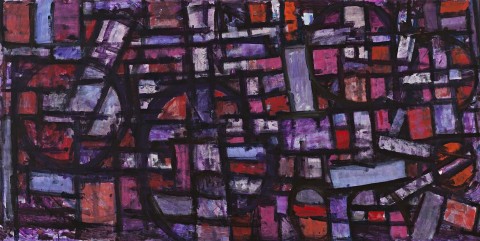SEQUENCE, c.1968 – 75
ROGER KEMP
synthetic polymer paint on paper on canvas
151.0 x 300.0 cm
Estate of the artist, Melbourne
Sotheby's, Melbourne, 19 September 2005, lot 43
Company Collection, Sydney
Confident, international, and boldly contemporary in its creative ambition, Sequence, c.1968 – 75 stands at the forefront of Roger Kemp’s mid-1970s work. He was of the same generation as America’s abstract expressionists, and the art of this diligent Australian master was uncannily on a similar wavelength. Kemp had begun crafting semi-abstract pictures of visionary figures while still a young modern painter in the 1930s. Human progress was his driving theme as he arranged those figures into geometric patterns, aspiring to convey our changing place in the cosmos.
Sequence represents the culmination of what had been a long, solitary road. Painted soon after a sojourn working and exhibiting in London, it shows a gutsy mature style approach where the artist stepped up scale, gained luminosity in his handling of colour, and, most of all, achieved an unmistakable expressiveness. Kemp would unfurl and staple wide rolls of imported paper across his studio wall, before drawing a loose compositional structure in conté crayon. Then he energetically set to work, applying paint in a quick steady manner. Using a roller to set in rectangles, then his brush to establish a strong structural armature, then taking up his roller, again, set in coloured squares. And so it went on for day upon day as Kemp refined his visual idea.
There was a symbolic intent guiding Kemp’s Sequence works through the mid-1970s. The art historian Patrick McCaughey, a devoted supporter who saw them painted, explains, ‘Roger believed the forms and rhythm of his brush configured on the canvas or sheet of paper were the visible forms of an unseen rhythm of the universe, of the physical world’.1 With this composition square and circle represent the scientific and the spiritual, those alternate outlooks humanity unceasingly strives to resolve.
Sequence was painted in systematic steps. What is necessarily an intricate composition being built from elemental shapes: squares and rectangles, with the suggestion of fugitive circles. Kemp arranges them using his preferred palette of red and blue with shades of purple or mauve, deploying white accents to set positive visual notes, while firmly establishing structure with thick black strokes. The artist, who studied music in his youth, would liken this to classical composition, showing studio visitors how he carefully built up visual structures in an integrated semi-harmonic manner not unlike Bach, his favourite composer.
The rhythmic looseness to Sequence is characteristic of Kemp’s best 1970s work, geometry being handled with a jaunty confidence. His sure command of improvised form accounts for a strong sense of compositional balance in what is an asymmetrical work. The left side of the composition is not a mirror image of the right, but in a design sense the painting’s right visually stabilises or completes the left. In this the viewer will also see how Kemp animates the composition with a joyous sense of restless activity.
Sequence strongly holds its own in pictorial terms. Representing Roger Kemp at his best, this is sophisticated art for the mature eye—like a brooding passage from Bach, Sequence resonates with a musical richness.
1. Patrick McCaughey, The Bright Shapes and the True Names: A Memoir, Text Publishing, Melbourne, 2003, p. 102
DR CHRISTOPHER HEATHCOTE
The major retrospective exhibition, Roger Kemp: Visionary Modernist, is currently showing at the National Gallery of Victoria, 23 August – 1 December 2019
